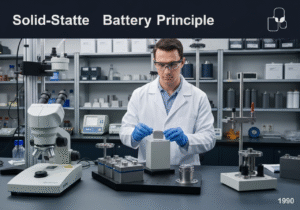
Solid-state batteries represent a transformative leap in energy storage technology, replacing liquid electrolytes with solid materials to enhance safety and energy density. These batteries utilize ceramic, glass, or sulfide-based electrolytes, which significantly reduce risks associated with leakage and flammability. Their architecture enables higher voltage operation and improved thermal stability, making them attractive for electric vehicles and portable electronics. Challenges remain in achieving scalable manufacturing processes and ensuring long-term interface stability between electrodes and solid electrolytes.
This is our latest selection of worldwide publications and patents in english on Solid-State Batteries, between many scientific online journals, classified and focused on solid electrolyte interphase, LLZO, Li10GeP2S12, NASICON, perovskite, lithium phosphorus oxynitride, bipolar stacking, interfacial resistance, dendrite growth, solid electrolyte, ceramic electrolyte, sulfide electrolyte, polymer electrolyte, oxide electrolyte, halide electrolyte, lithium metal anode, ionic conductivity, electrochemical stability, chemo mechanical damage, thermal runaway, solid-state battery, silicon based anode, solid-state batteries, lithium cobalt oxide, lithium iron phosphate and lithium nickel manganese cobalt oxide.
Advances and Horizons in Ceramic Materials Research
Published on 2025-10-21 by Agata Lisińska-Czekaj, Tomasz Pikula @MDPI
Abstract: In this Special Issue entitled Novel Ceramic Materials: Processes, Properties and Applications, 18 articles are brought together. The contributions illustrated the remarkable versatility of ceramics—from bioceramics that heal bone and fight infection, to solid electrolytes and multiferroics powering clean energy, and glass ceramics and zeolite composites safeguarding our environment. Articles on glazes, archaeological pottery, and innovative joining methods reminded us that ceramic[...]
Our summary: This Special Issue presents 18 articles on novel ceramic materials and their diverse applications. It highlights the versatility of ceramics in fields such as biomedicine, clean energy, and environmental protection. Additionally, it emphasizes the connection between traditional ceramic practices and contemporary scientific advancements.
ceramic materials, bioceramics, solid electrolytes, glass ceramics
Publication
Ternary Synergistic Electrolyte Enabling Stable Li-Ion Battery Operation Across −40 °C to 60 °C
Published on 2025-10-21 by Yali Zhao, Yutao Liu, Jingju Liu, Daofa Ying, Xuanlin Gong, Linjin Xie, Xiaohan Guo, Caiyun Yao, Baohui Chen, Chuanping Wu @MDPI
Abstract: The operational failure of lithium-ion batteries under extreme temperatures (−40~60 °C) stems primarily from electrolyte limitations. While prior efforts improved either low-temperature or high-temperature performance independently, holistic electrolyte design with practical validation remains elusive. Herein, we develop an all-climate electrolyte (ACE) through synergistic coordination of solvent, Li salt, and additive, achieving low viscosity (<10 mPa&am[...]
Our summary: This study presents a novel all-climate electrolyte (ACE) for lithium-ion batteries, ensuring stable operation from -40°C to 60°C. The electrolyte achieves low viscosity and high ionic conductivity through a synergistic design of solvent, Li salt, and additive. It enables significant performance improvements, including zero capacity decay over 500 cycles and enhanced interfacial stability.
Ternary Electrolyte, Lithium-Ion Battery, Extreme Temperatures, Ionic Conductivity
Publication
Study on the Passivation of Defect States in Wide-Bandgap Perovskite Solar Cells by the Dual Addition of KSCN and KCl
Published on 2025-10-21 by Min Li, Zhaodong Peng, Xin Yao, Jie Huang, Dawei Zhang @MDPI
Abstract: Wide-bandgap (WBG) perovskite solar cells (PSCs) are critical for high-efficiency tandem photovoltaic devices, but their practical application is severely limited by phase separation and poor film quality. To address these challenges, this study proposes a dual-additive passivation strategy using potassium thiocyanate (KSCN) and potassium chloride (KCl) to synergistically optimize the crystallinity and defect state of WBG perovskite films. The selection of KSCN/KCl is based on their complementar[...]
Our summary: Study proposes dual-additive passivation strategy using KSCN and KCl to optimize WBG perovskite films, enhancing film crystallinity, reducing surface roughness, and improving device performance. Champion device shows 19.4% efficiency improvement over control.
Passivation, Wide-bandgap, Perovskite, Solar Cells
Publication
Bridging Molecular Design, Multifunctionality, and Device Applications Across Batteries, Supercapacitors, Solid-State Systems, and Beyond
Published on 2025-10-20 by Akhil Sharma, Sonu Sharma, Monu Sharma, Vikas Sharma, Shivika Sharma, Iyyakkannu Sivanesan @MDPI
Abstract: Polymer materials have become promising candidates for next-generation energy storage, with structural tunability, multifunctionality, and compatibility with a variety of device platforms. They have a molecular design capable of customizing ion and electron transport routes, integrating redox-active species, and enhancing interfacial stability, surpassing the drawbacks of traditional inorganic systems. New developments have been made in multifunctional polymers that have the ability to combine c[...]
Our summary: Polymer materials are promising for next-generation energy storage due to their structural tunability and multifunctionality. They enhance performance in batteries and supercapacitors by integrating conductive and mechanical properties. Sustainable innovations and AI-driven polymer discovery are paving the way for reliable and safe energy solutions.
Polymers, Energy Storage, Multifunctionality, Nanocomposites
Publication
A Review of the Intrinsic Chemical Stability Challenge in Operational Perovskite Photovoltaics
Published on 2025-10-19 by Huān Bì, Zhen Wang, Zhenhua Xu @MDPI
Abstract: Although the power conversion efficiency of perovskite photovoltaics (PVs) has achieved significant progress, the operational stability is still a critical issue for their commercialization. Compared to inorganic semiconductor materials, organic species in perovskites are intrinsically unstable under long-term illumination, heat, and bias stresses. These organic species exhibit higher chemical reactivity, which can complicate the degradation mechanisms or model of perovskite PVs. In this review,[...]
Our summary: This review highlights the intrinsic chemical stability challenges in perovskite photovoltaics. It discusses the degradation mechanisms driven by organic species and their reactions under operational stresses. Strategies for enhancing the operational stability and extending the lifetime of perovskite PVs are also presented.
perovskite photovoltaics, chemical stability, degradation mechanisms, operational lifetime
Publication
Eco-Friendly Membrane Separators Based on Furanoate Polymers for Li-Ion Batteries
Published on 2025-10-18 by Sofia Santi, Luca Bargnesi, Giulia Fredi, Michelina Soccio, Nadia Lotti, Catia Arbizzani, Andrea Dorigato @MDPI
Abstract: Conventional lithium-ion battery separators made from petroleum-based polymers pose environmental concerns due to their non-renewable origin and energy-intensive production. Novel bio-based alternatives, such as poly(alkylene 2,5-furanoate)s (PAFs), offer improved sustainability and favorable thermomechanical properties. This work investigated electrospun mats of poly(butylene 2,5-furandicarboxylate) (PBF) and poly(pentamethylene 2,5-furandicarboxylate) (PPeF), which, despite structural similari[...]
Our summary: This study explores eco-friendly membrane separators made from furanoate polymers for lithium-ion batteries. It compares poly(butylene 2,5-furandicarboxylate) and poly(pentamethylene 2,5-furandicarboxylate), highlighting their distinct properties and performance. The findings indicate that these bio-based materials can enhance battery performance while addressing environmental concerns.
Furanoate polymers, lithium-ion batteries, eco-friendly separators, electrospun mats
Publication
Enhancing metal ion battery longevity through minimized coordinating diluent
Patent published on the 2025-10-16 in WO under Ref WO2025217417 by THE PENN STATE RES FOUNDATION [US] (Wang Donghai [us], Li Guoxing [us])
Abstract: Embodiments relate to an electrolyte composition including a cyclic fluorinated ether diluent configured to configured to control reactions between a metal anode of a metal ion battery and the electrolyte composition. Embodiments further relate to a solid electrolyte interphase (SEI) bilayer formed on a surface of the metal anode and to a metal ion battery including the cyclic fluorinated ether diluent and/or the SEI bilayer.[...]
Our summary: The invention improves metal ion battery longevity by using a cyclic fluorinated ether diluent. This diluent controls reactions between the metal anode and the electrolyte. Additionally, a solid electrolyte interphase bilayer is formed on the metal anode surface.
electrolyte composition, metal ion battery, cyclic fluorinated ether, solid electrolyte interphase
Patent
Organic luffa aluminum-ion battery
Patent published on the 2025-09-18 in US under Ref US2025293394 by FUEL CELLS GLOBAL LTD [US] (Lafe Olurinde Ebenezer [us])
Abstract: A method and apparatus for storing electricity using a rechargeable electrochemical cell with a tubular aluminum anode, bunched carbon graphite rods as the cathode, a luffa sponge electrolyte medium, and a solid electrolyte. The invention teaches the use of common ultra-low-cost material components, and a simple electrochemical cell construction method.[...]
Our summary: The invention describes a rechargeable aluminum-ion battery utilizing a luffa sponge as the electrolyte. It employs bunched carbon graphite rods as the cathode and a tubular aluminum anode. The design focuses on using low-cost materials and straightforward construction methods.
luffa, aluminum-ion battery, electrochemical cell, renewable materials
Patent


























